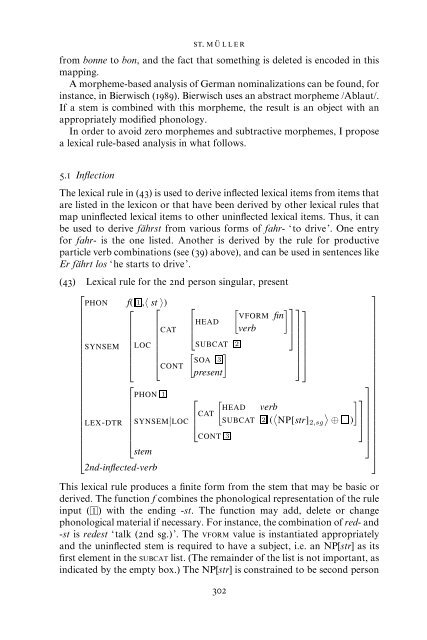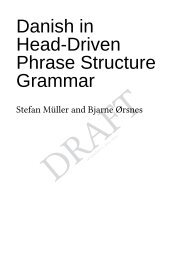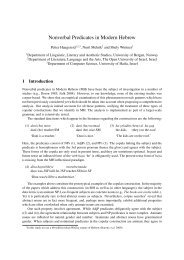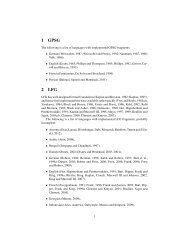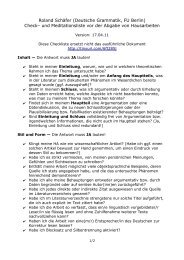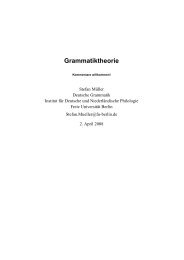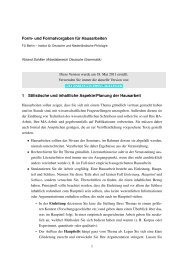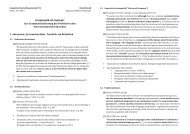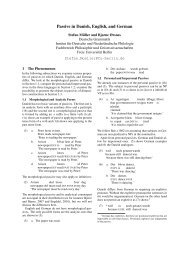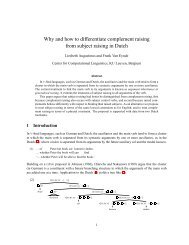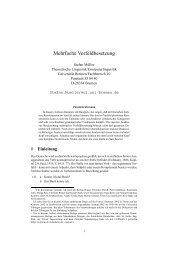Solving the bracketing paradox - German Grammar Group FU Berlin
Solving the bracketing paradox - German Grammar Group FU Berlin
Solving the bracketing paradox - German Grammar Group FU Berlin
Create successful ePaper yourself
Turn your PDF publications into a flip-book with our unique Google optimized e-Paper software.
ST. MÜLLER<br />
from bonne to bon, and <strong>the</strong> fact that something is deleted is encoded in this<br />
mapping.<br />
A morpheme-based analysis of <strong>German</strong> nominalizations can be found, for<br />
instance, in Bierwisch (1989). Bierwisch uses an abstract morpheme /Ablaut/.<br />
If a stem is combined with this morpheme, <strong>the</strong> result is an object with an<br />
appropriately modified phonology.<br />
In order to avoid zero morphemes and subtractive morphemes, I propose<br />
a lexical rule-based analysis in what follows.<br />
5.1 Inflection<br />
The lexical rule in (43) is used to derive inflected lexical items from items that<br />
are listed in <strong>the</strong> lexicon or that have been derived by o<strong>the</strong>r lexical rules that<br />
map uninflected lexical items to o<strong>the</strong>r uninflected lexical items. Thus, it can<br />
be used to derive fährst from various forms of fahr- ‘to drive’. One entry<br />
for fahr- is <strong>the</strong> one listed. Ano<strong>the</strong>r is derived by <strong>the</strong> rule for productive<br />
particle verb combinations (see (39) above), and can be used in sentences like<br />
Er fährt los ‘he starts to drive’.<br />
(43) Lexical rule for <strong>the</strong> 2nd person singular, present<br />
⎡<br />
⎤<br />
PHON f( 1 ,〈 st 〉)<br />
⎡ ⎡ ⎡ [ ] ⎤⎤⎤<br />
⎢<br />
CAT ⎣ HEAD VFORM fin<br />
verb<br />
⎥<br />
⎦<br />
SYNSEM<br />
LOC<br />
SUBCAT 2<br />
⎢ ⎢ [ ]<br />
⎣ ⎣ SOA 3<br />
⎥<br />
⎥<br />
⎦<br />
CONT<br />
⎦<br />
present<br />
⎡<br />
⎤<br />
PHON 1<br />
⎡ [ ] ⎤<br />
HEAD verb<br />
LEX-DTR<br />
⎢<br />
SYNSEM|LOC<br />
⎣ CAT SUBCAT 2 ( 〈 〉 NP[str] 2,sg ⊕ )<br />
⎥<br />
⎦<br />
⎢<br />
⎣<br />
CONT 3<br />
⎥<br />
⎦<br />
⎢<br />
⎣<br />
stem<br />
⎥<br />
⎦<br />
2nd-inflected-verb<br />
This lexical rule produces a finite form from <strong>the</strong> stem that may be basic or<br />
derived. The function f combines <strong>the</strong> phonological representation of <strong>the</strong> rule<br />
input (1) with <strong>the</strong> ending -st. The function may add, delete or change<br />
phonological material if necessary. For instance, <strong>the</strong> combination of red- and<br />
-st is redest ‘talk (2nd sg.)’. The VFORM value is instantiated appropriately<br />
and <strong>the</strong> uninflected stem is required to have a subject, i.e. an NP[str] as its<br />
first element in <strong>the</strong> SUBCAT list. (The remainder of <strong>the</strong> list is not important, as<br />
indicated by <strong>the</strong> empty box.) The NP[str] is constrained to be second person<br />
302


